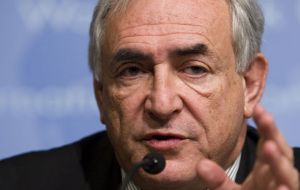MercoPress. South Atlantic News Agency
IMF announces more loans and zero interest for the world’s poorest countries
 IMF Managing Director Dominique Strauss-Kahn announced 8 billion USD for poor countries during the next two years
IMF Managing Director Dominique Strauss-Kahn announced 8 billion USD for poor countries during the next two years The IMF has announced a new framework for loans to the world’s poorest nations, including increased resources, a doubling of borrowing limits, zero interest rates until the end of 2011, and more flexible terms.
The IMF’s Executive Board approved the package of measures that will sharply increase the loan resources available to low-income countries. The resources—including from the planned sale of IMF gold—are expected to boost the IMF concessional lending to up to 17 billion US dollars through 2014, including up to 8 billion USD over the next two years.
In addition, the IMF announced zero interest payments up to the end of 2011 for all concessional loans to low-income members and lower interest rates on a permanent basis thereafter. A new set of lending instruments will underpin this increased support.
“This is an unprecedented scaling up of IMF support for the poorest countries, in sub-Saharan Africa and all over the world,” said IMF Managing Director Dominique Strauss-Kahn in a statement accompanying the July 29 announcement.
The crisis originated in the advanced economies and has had its most visible impact on the emerging market countries. But a third wave of the crisis has threatened the remarkable economic achievements many low-income countries have made over the past decade.
An IMF report on the implications of the global financial crisis for low-income countries had warned in March that the global financial crisis has hit poor countries especially hard, posing serious threats to their hard-won gains in boosting economic growth and creating a need for additional foreign financing to mitigate the impact of the crisis.
In response to this situation IMF has already more than doubled its financial assistance to low-income countries. New IMF concessional lending commitments to low-income countries through mid-July 2009 reached 2.9 billion compared with 1.5 billion for the whole of 2008.
In addition, the IMF’s Executive Board recently backed the Managing Director's proposal for a new general allocation of 250 billion of Special Drawing Rights into the global economy, of which more than 18 billion will help bolster the foreign exchange reserves and relax the financing constraints of low-income countries.
Strauss-Kahn said that “All this represents a historic effort by the Fund to help the world’s poor.” He added that there would be greater emphasis in Fund-supported programs on poverty reduction and growth objectives across all its new lending instruments, including targets to safeguard social and other priority spending.
The new lending windows are expected to become effective later this year, when donor countries have given their final consent. At that time, existing concessional arrangements will automatically be converted into ECF arrangements. Existing arrangements under the Exogenous Shocks Facility, however, will remain in effect, and new ones that have already been prepared could still be approved during a three-month window.
Some of the money to boost IMF lending to low-income countries will come from the sales of gold. The IMF Executive Board will consider a plan for the Fund to sell about 400 metric tons of gold in order to create a new income model for the institution. In order to meet the financing needs of the low-income countries during the global crisis, some of the proceeds of those sales will be used to help provide new subsidy resources for the concessional lending to those countries.




Top Comments
Disclaimer & comment rulesCommenting for this story is now closed.
If you have a Facebook account, become a fan and comment on our Facebook Page!